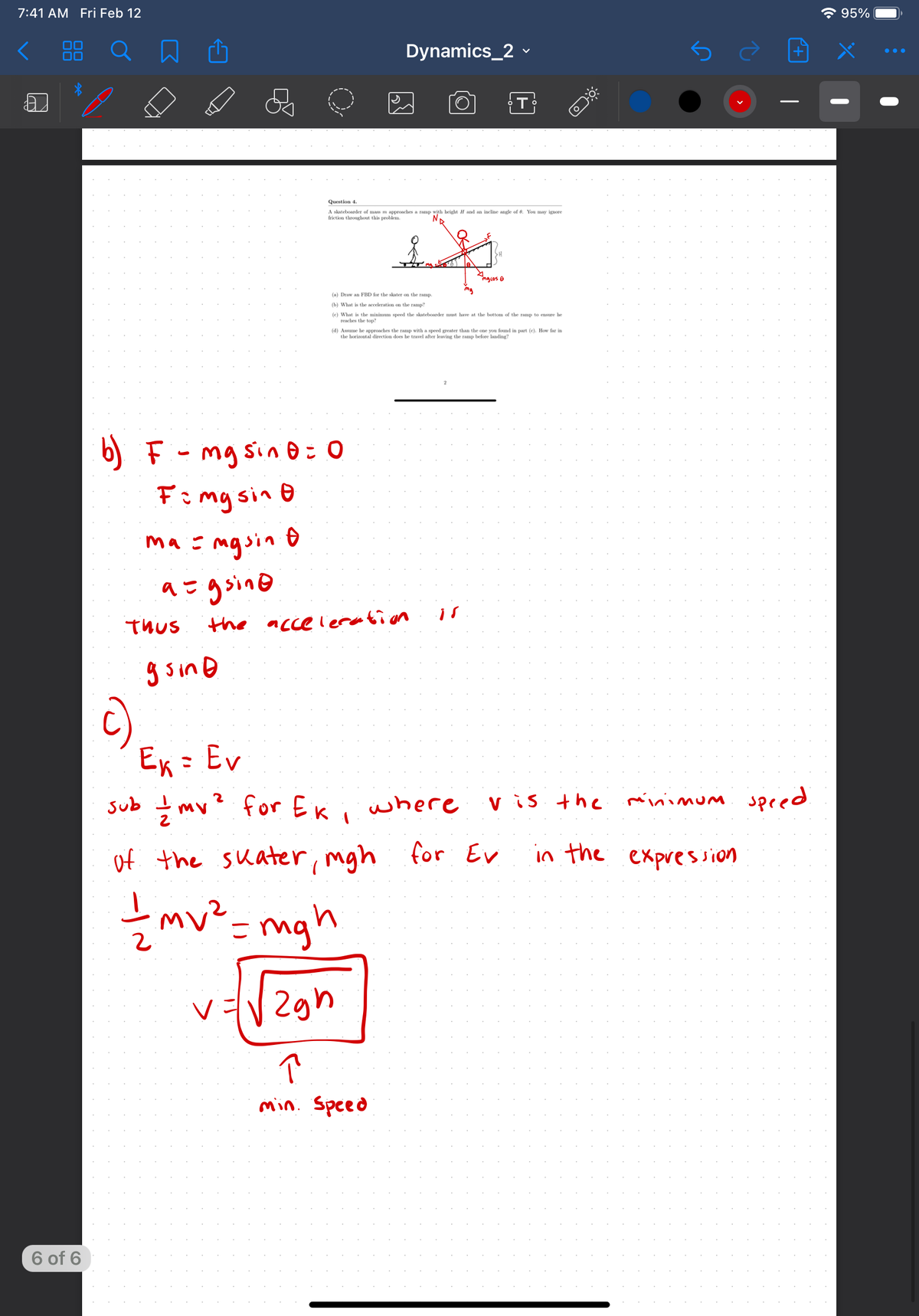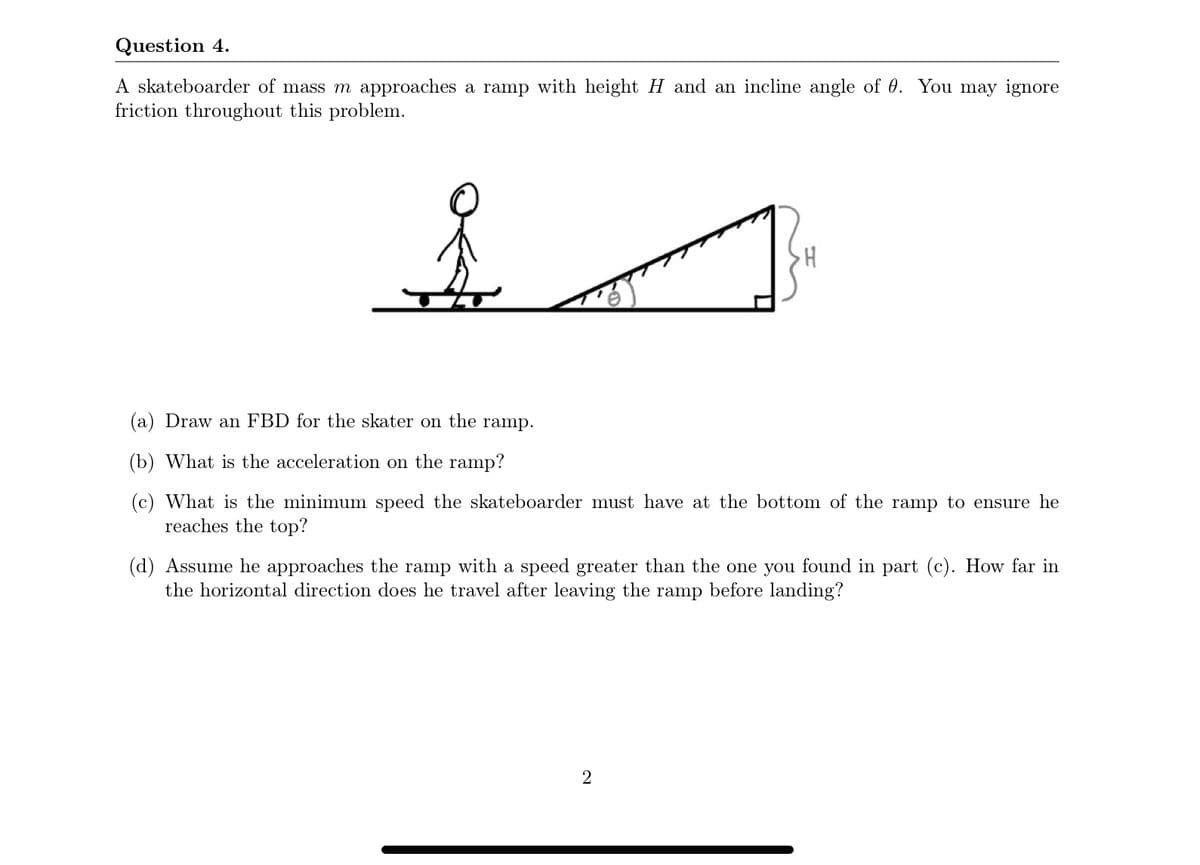Question 4. A skateboarder of mass m approaches a ramp with height H and an incline angle of 0. You may ignore friction throughout this problem. (a) Draw a FBD for the skater on the ramp. (b) What is the acceleration on the ramp? (c) What is the minimum speed the skateboarder must have at the bottom of the ramp to ensure he reaches the top? (d) Assume he approaches the ramp with a speed greater than the one you found in part (c). How far in the horizontal direction does he travel after leaving the ramp before landing?
Question 4. A skateboarder of mass m approaches a ramp with height H and an incline angle of 0. You may ignore friction throughout this problem. (a) Draw a FBD for the skater on the ramp. (b) What is the acceleration on the ramp? (c) What is the minimum speed the skateboarder must have at the bottom of the ramp to ensure he reaches the top? (d) Assume he approaches the ramp with a speed greater than the one you found in part (c). How far in the horizontal direction does he travel after leaving the ramp before landing?
Classical Dynamics of Particles and Systems
5th Edition
ISBN:9780534408961
Author:Stephen T. Thornton, Jerry B. Marion
Publisher:Stephen T. Thornton, Jerry B. Marion
Chapter2: Newtonian Mechanics-single Particle
Section: Chapter Questions
Problem 2.13P:
A particle moves in a medium under the influence of a retarding force equal to mk(υ3+ a2υ), where k...
Related questions
Question
please only answer part d

Transcribed Image Text:7:41 AM Fri Feb 12
A 95%
Dynamics_2 -
5
00
T
Question 4.
A skateboarder of mass m approaches a ramp with height H and an incline angle of 8. You may ignore
friction throughout this problem.
Angcos o
my
(a) Draw an FBD for the skater on the ramp.
(b) What is the acceleration on the ramp?
(c) What is the minimum speed the skateboarder must have at the bottom of the ramp to ensure he
reaches the top?
(d) Assume he approaches the ramp with a speed greater than the one you found in part (e). How far in
the horizontal direction does he travel after leaving the ramp before landing?
b) F- mg sin 0 : 0
Fimgsin 0
ma = mgsin t
a= gsin@
is
thus
the acce leration
g sine
c)
Ex = Ev
* mv for Eki where vis the minimum spred
of the suater, mgh for Ev
in the expression
mv²=mgh
2gn
min. Speed
6 of 6

Transcribed Image Text:Question 4.
A skateboarder of mass m approaches a ramp with height H and an incline angle of 0. You may ignore
friction throughout this problem.
(a) Draw an FBD for the skater on the ramp.
(b) What is the acceleration on the ramp?
(c) What is the minimum speed the skateboarder must have at the bottom of the ramp to ensure he
reaches the top?
(d) Assume he approaches the ramp with a speed greater than the one you found in part (c). How far in
the horizontal direction does he travel after leaving the ramp before landing?
Expert Solution
Step 1
Suppose the velocity of skateboarder is u, then the horizontal component and vertical component of velocity is given by,
Trending now
This is a popular solution!
Step by step
Solved in 3 steps

Knowledge Booster
Learn more about
Need a deep-dive on the concept behind this application? Look no further. Learn more about this topic, physics and related others by exploring similar questions and additional content below.Recommended textbooks for you

Classical Dynamics of Particles and Systems
Physics
ISBN:
9780534408961
Author:
Stephen T. Thornton, Jerry B. Marion
Publisher:
Cengage Learning

Classical Dynamics of Particles and Systems
Physics
ISBN:
9780534408961
Author:
Stephen T. Thornton, Jerry B. Marion
Publisher:
Cengage Learning